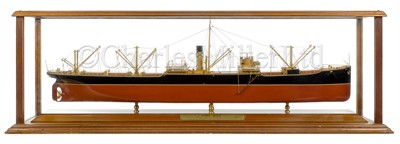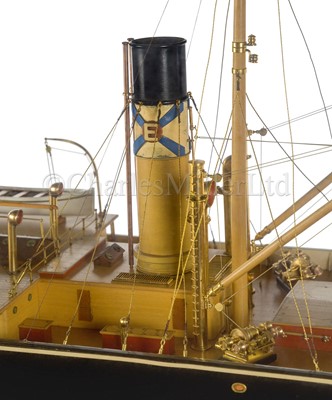27th Apr, 2021 10:00
Maritime and Scientific Models, Instruments & Art (Untiring)
141
[M] A FINE AND ORIGINAL BUILDER’S MODEL FOR THE S.S. GENERAL CHURCH BUILT FOR THE BYRON S.S. CO. BY WILLIAM DOXFORD & SONS LTD, 1917
A FINE AND ORIGINAL BUILDER’S MODEL FOR THE S.S. GENERAL CHURCH BUILT FOR THE BYRON S.S. CO. BY WILLIAM DOXFORD & SONS LTD, 1917
the laminated and carved hull with gold-plated propeller, lowered companionway and bilge keels, with lacquered boxwood decks with lined hatch covers and bridge, complete with detailed gilt fittings as appropriate, including open bridge with water casks, fire buckets, helm binnacle and telegraphs, stayed funnel with company livery, fitted open lifeboats and davits, emergency double helm over rudder flanked by spare anchors etc.; mounted on four gilt columns to raised display base with fine engraved lacquered brass builder’s plates within original wooden glazed case; overall measurements -- 20½ x 63 x 16in. (52 x 160 x 40.5cm.)
Named for Sir Richard Church (1784-1873), a very prominent Grecophile and the British commander of the Greek forces during the final stages of the Greek War of Independence in 1827-29, the mixed cargo steamer General Church was forced to fly some controversial colours towards the end of her twenty-five year career and also to become a wartime casualty, seemingly by mistake.
Built by William Doxford & Sons Ltd in their Pallion yard at Sunderland to the order of the Byron Steamship Company (Embiricos Brothers) of London, she was launched on 18th October 1917 and completed the following month. Registered in London at 6,600 tons gross (4,148 net), she measured 520 feet in length with a 54 foot beam and was engined by the North Eastern Marine Engineering Co. Ltd.
When barely two months old, on 4th February 1918, she was torpedoed by the German submarine UB-49 off Genoa, whilst inbound for that port from Saint John, New Brunswick, in ballast. Two crewmen were killed, but she made it into Genoa and was repaired for further service. 14 years later (in 1931), she was sold to the European Shipping Co. Ltd of London, but changed hands again the following year when she was purchased by N.G. Nicolaou of Panama who renamed her Ekaterini Nicolaou. After a further six years, she was sold to A.G. Pappadakis of Piraeus in 1938 and renamed Victoria.
On 16th May 1938, whilst on passage through the Mediterranean, she was stopped and seized by the Spanish Nationalist auxiliary cruiser Mar Cantabrico sailing in company with the minelayer Volcano. In the event, the Victoria was to prove the largest foreign prize taken during the Spanish Civil War and, following the verdict of the Prize Court, went back to sea under Spanish government colours and renamed Cantabro. Renamed again in 1939, this time as the Castillo Oropesa, she was anchored in Spanish territorial waters off Melilla, in Spanish Morocco, on 8th November 1941, when she was torpedoed and sunk – despite her neutral status – by the Italian submarine Dandalo, apparently by mistake. Although there was no loss of life, it was deeply ironic that she was sunk by an Italian vessel despite the close bonds between Spain’s General Franco and Fascist Italy’s Benito Mussolini.
Sold for £18,600
Estimated at £7,000 - £9,000
(inc. buyer's premium of 24%)
Condition Report
extremely fine overall condition
We are pleased to provide you with a general report of the condition of this property. Since we are not professional conservators or restorers, we urge you to consult with a restorer or conservator of your choice who will be better able to provide a detailed, professional report. Prospective buyers should inspect each lot to satisfy themselves as to condition and must understand that any statement made by Charles Miller Ltd is merely a subjective, qualified opinion. Prospective buyers should also refer to any Important Notices regarding this sale, which are printed in the Sale Catalogue. NOTWITHSTANDING THIS REPORT OR ANY DISCUSSIONS CONCERNING A LOT, ALL LOTS ARE OFFERED AND SOLD “AS IS” IN ACCORDANCE WITH THE CONDITIONS OF BUSINESS PRINTED IN THE SALE CATALOGUE.
A FINE AND ORIGINAL BUILDER’S MODEL FOR THE S.S. GENERAL CHURCH BUILT FOR THE BYRON S.S. CO. BY WILLIAM DOXFORD & SONS LTD, 1917
the laminated and carved hull with gold-plated propeller, lowered companionway and bilge keels, with lacquered boxwood decks with lined hatch covers and bridge, complete with detailed gilt fittings as appropriate, including open bridge with water casks, fire buckets, helm binnacle and telegraphs, stayed funnel with company livery, fitted open lifeboats and davits, emergency double helm over rudder flanked by spare anchors etc.; mounted on four gilt columns to raised display base with fine engraved lacquered brass builder’s plates within original wooden glazed case; overall measurements -- 20½ x 63 x 16in. (52 x 160 x 40.5cm.)
Named for Sir Richard Church (1784-1873), a very prominent Grecophile and the British commander of the Greek forces during the final stages of the Greek War of Independence in 1827-29, the mixed cargo steamer General Church was forced to fly some controversial colours towards the end of her twenty-five year career and also to become a wartime casualty, seemingly by mistake.
Built by William Doxford & Sons Ltd in their Pallion yard at Sunderland to the order of the Byron Steamship Company (Embiricos Brothers) of London, she was launched on 18th October 1917 and completed the following month. Registered in London at 6,600 tons gross (4,148 net), she measured 520 feet in length with a 54 foot beam and was engined by the North Eastern Marine Engineering Co. Ltd.
When barely two months old, on 4th February 1918, she was torpedoed by the German submarine UB-49 off Genoa, whilst inbound for that port from Saint John, New Brunswick, in ballast. Two crewmen were killed, but she made it into Genoa and was repaired for further service. 14 years later (in 1931), she was sold to the European Shipping Co. Ltd of London, but changed hands again the following year when she was purchased by N.G. Nicolaou of Panama who renamed her Ekaterini Nicolaou. After a further six years, she was sold to A.G. Pappadakis of Piraeus in 1938 and renamed Victoria.
On 16th May 1938, whilst on passage through the Mediterranean, she was stopped and seized by the Spanish Nationalist auxiliary cruiser Mar Cantabrico sailing in company with the minelayer Volcano. In the event, the Victoria was to prove the largest foreign prize taken during the Spanish Civil War and, following the verdict of the Prize Court, went back to sea under Spanish government colours and renamed Cantabro. Renamed again in 1939, this time as the Castillo Oropesa, she was anchored in Spanish territorial waters off Melilla, in Spanish Morocco, on 8th November 1941, when she was torpedoed and sunk – despite her neutral status – by the Italian submarine Dandalo, apparently by mistake. Although there was no loss of life, it was deeply ironic that she was sunk by an Italian vessel despite the close bonds between Spain’s General Franco and Fascist Italy’s Benito Mussolini.
Auction: Maritime and Scientific Models, Instruments & Art (Untiring), 27th Apr, 2021
Mercantile (Sail) 1-123
Mercantile (Steam) 124-166
Naval (Sail) 170-252
Naval (Steam) 255-339
Navigational & Scientific Instruments 340-395
--
Printed catalogues available at £20 (+P&P)
--
--
THIS SALE WILL BE CONDUCTED LIVE ONLINE ONLY
You will not be able to bid live in the room. Absentee bids may be left via the website or using a bid form or you can bid via one of three online platforms. Absentee bids on our site must be left by 9am on the morning of the sale. Unfortunately, we cannot offer telephone bidding for this sale
- UKAuctioneers.com – this service offers a choice of either paying a one-off £3.95 flat fee for the sale and no further charges, or 3% of the hammer price. Charles Miller Ltd will refund successful buyers who bid via the £3.95 flat fee
- The-Saleroom.com – charges 5% of the hammer price
- Invaluable.com – charges 3% of the hammer price
Viewing
By appointment only, please call or email
enquiries@charlesmillerltd.com
+44 (0)20 7806 5530



